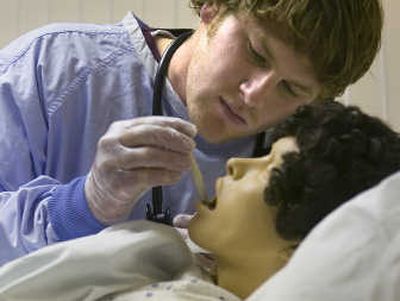Learning on their feet

Things aren’t looking so good for Mr. Chester Pain.
He’s 54 years old and has come to the emergency room with crushing chest pain.
While his heart monitor beeps, nurses give him aspirin, morphine and a beta blocker. They strap an oxygen mask over his nose and mouth.
“I feel better now,” he tells the nurses.
But then his heart rate plummets and he goes into cardiac arrest.
A nurse rushes to do CPR, pushing down on his chest with all her might.
Pain’s pulse returns. But the patient won’t be leaving his hospital bed anytime soon.
Chester Pain is actually a sophisticated human simulator in use at the Washington State University Riverpoint Campus in Spokane. The computerized mannequin is one of several being poked, prodded and examined at WSU in Spokane, by both nursing and pharmacy students.
Human simulation is fast becoming the gold standard at medical and nursing schools around the country, and WSU hopes to expand its simulator program in coming years.
“There’s nothing like having to think on your feet instead of in the seat,” says Suzie Kardong-Edgren, an assistant professor of nursing at WSU and national leader in the field of human simulation.
Think of the Resusci Anne dummies used in CPR certification classes. Today’s mannequins, some of which are manufactured by the same company as Anne, are their souped-up, high-tech, robotic cousins.
Students can practice a huge range of tasks on simulators like Chester Pain. They can listen to his heart, his breath sounds and bowel sounds. They can check his pupils for dilation. They can feel the pulses in his wrists and feet. They can inject his veins with drugs, poke a needle into his lungs and insert a tracheotomy tube into his neck.
Some models can be programmed to speak so students can experience interviewing a patient.
At WSU, students must be in scrubs before working on one of the mannequins, and they must follow all of the required sanitation procedures such as hand-washing and glove-wearing. The idea is to make the simulated experience as realistic as possible.
“The real opportunity is in the ability for students to learn in an applied way that’s very different from reading in a book, from listening to a lecture, from talking about a patient’s case on paper,” says Brenda Bray, a clinical assistant professor in pharmacy at WSU. “You’d rather have somebody practice intubating a few times on a mannequin before doing it on a patient.”
Simulation as a technique to train health-care providers is growing in interest nationwide, says Beverlee Anderson, director of the New Mexico-based Society for Simulation in Health Care. Her organization, one of several in the field, has grown to 2,000 members since its founding in 2004. She estimates there are 300 to 500 simulation centers of varying size around the country.
“It’s a very cost-effective way to do education,” Anderson says. “You can change what you’re teaching people fairly quickly.”
That’s not to say that human simulators are inexpensive.
A simulator like Chester Pain runs about $45,000. There’s a top-end $250,000 model that allows students to see the effects of drugs on a patient under true-to-life variables. And there’s also a basic $12,000 simulator that looks less realistic than the pricier ones but can still be used to teach a variety of skills.
“For the more novice students, the cheaper ones are fine,” Kardong-Edgren says.
By the time the WSU School of Nursing moves into its new, $34 million building on the Riverpoint campus next fall, the school will have the beginnings of a human-simulation center. The building has three simulation rooms and one for debriefing. A control room will be housed on another floor so the students will have no interaction with the instructor who runs the computer and tells the dummy how to respond.
The school is waiting to hear if it will receive $1.5 million in federal funding earmarked to purchase equipment for the Inland Northwest Human Simulation Lab. The funding decision is currently being considered by the Senate.
School officials also hope to find community partners, such as first-responders and hospitals, to collaborate on the simulation center to pool resources and expand training opportunities.
“We’re hoping for bigger things in the future,” Kardong-Edgren says.
Students who have gone through training using human simulators call the experience stressful, yet realistic. They say they’ve learned far more working on the mannequin than in a traditional lecture.
Jessica Sandstrom, 21, is in her second semester of nursing school at WSU. She works at a nursing home as a nurse technician and was able to recognize that one of her patients was having had a stroke after having seen the same symptoms during a simulation.
“I knew what signs to look for,” Sandstrom says. “I knew to look in his eyes. They were fixed and dilated.”
Sandstrom says she would like to see more simulations used in her nursing classes.
“I’m a good student,” she says. “I get good grades. I can study all the time. But to put all that application under high stress, it’s so different … You have to learn how to work with people. You have to learn how to coordinate everyone. We have to take everything we learned and use it now.”